No one wants to lose valuable website data in a technical snafu or a hacking incident. With WordPress, you never have to. You may already know that it’s possible to secure your site by creating copies of it, but you might be wondering just exactly how to backup a WordPress site for free.
Thankfully, you can use a plugin to get the job done in just a few steps. You’re able to back up your site, save it safely in cloud storage, and then restore it at your leisure. What’s more, there are even tools, such as UpdraftPlus, that let you do this totally for free.
👉 In this post, we’ll start by discussing why you might want to back up your website. Then, we’ll show you how to backup WordPress sites in three easy steps. Let’s get to it!
Why backup a WordPress site
By design, WordPress is a user-friendly and secure Content Management System (CMS). So, if you’re using it for a simple site, and you take the time to familiarize yourself with it, chances are, you won’t run into any issues.
Still, there is a bit of a learning curve, and there are tons of things that can break or damage any website. This could be anything, ranging from a minor technical error to a major hacking event. In fact, according to Sucuri, 60% of websites analyzed in their test contained at least one backdoor and more than 95% of those websites run on WordPress [1].
Unfortunately, all websites are delicate, so even the smallest mistake or cyber assault could negatively impact functionality or completely take down your site. If that happens, you could lose all your work (in terms of web design) or valuable data you’ve already collected.
For instance, in the case of an online store, you could end up losing precious customer data. What’s more, without a backup of your site, your ecommerce business could be offline for longer than necessary. This would negatively affect your business’ reputation as well as your revenue.
On the other hand, your website may hold a lot of personal value or history. For example, if you run a personal blog, you could lose priceless blog entries.
However, when you backup your WordPress site, you’re able to create a full copy of it. This can include the complete design, databases, and any content. So, in case of an emergency, you can simply restore the most recent version of your site and move on with your life.
That’s why backing up your WordPress is a good idea, no matter what type of site you own or manage. 💡
How to backup a WordPress site for free
Now that you know why it’s important to backup a WordPress site, we’re going to show you how you can backup a WordPress site for free in three steps!
- Step 1: Install a free backup plugin
- Step 2: Configure your free WordPress backups
- Step 3: Restore your free backup
Step 1: Install a free backup plugin 🔌
The first step is to install a free backup plugin. Fortunately, there are tons of WordPress security plugins that can give you everything from malware scanning to complete backups.
When choosing a backup plugin, you’ll want to consider the following factors:
- Backup type. Some free tools only allow you to create partial backups. Make sure to look for one that lets you create full ones. This will make restoring your site easier.
- Storage options and limits. You’ll want to make sure you opt for a WordPress backup plugin that lets you save your backups in a remote storage location (such as Google Drive or Dropbox). If you can only save it locally (on your site’s server), you won’t be able to restore it when your server is down. Additionally, look out for any limits on storage.
- Ease of use. Consider the usability of a free WordPress backup plugin. For instance, if you’re a beginner, you probably don’t want to have to mess with the File Transfer Protocol (FTP) or phpMyAdmin in order to restore your backups.
After considering lots of free WordPress backup plugins, we’ve found that UpdraftPlus is hands down one of the best options:
The free version of this tool comes with everything you need – great news for everyone who wants to learn how to backup a WordPress site for free.
With UpdraftPlus, you’ll be able to create backups manually or schedule them to be automatically generated at specific intervals. It also provides you with plenty of options for remote storage.
What’s more, everything about the UpdraftPlus interface is super intuitive. That means creating and restoring your backups will be a breeze.
So, to get started with the plugin, navigate to your WordPress dashboard. Go to Plugins > Add New and use the search tool to find UpdraftPlus:
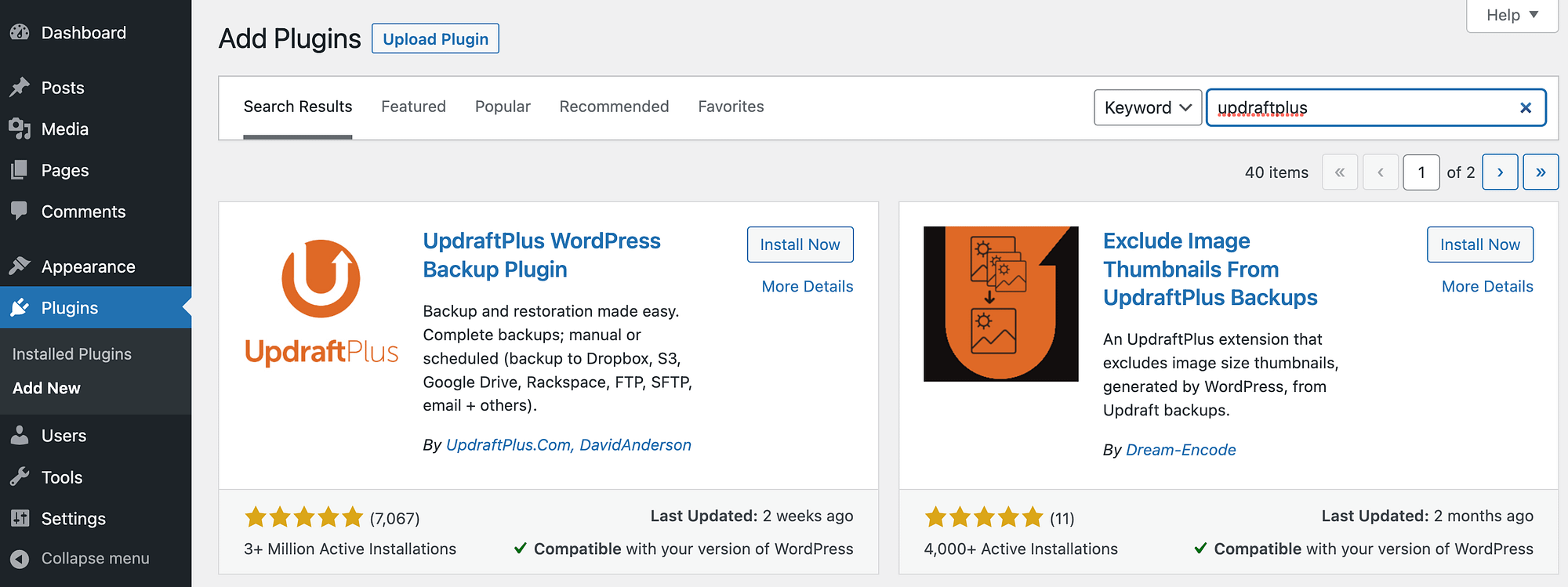
Then, click on Install Now, followed by Activate.
Step 2: Configure your free WordPress backups ⚙️
Now, you’re ready to go into the configuration phase of how to backup a WordPress site for free. Installing and activating the plugin will trigger a popup:
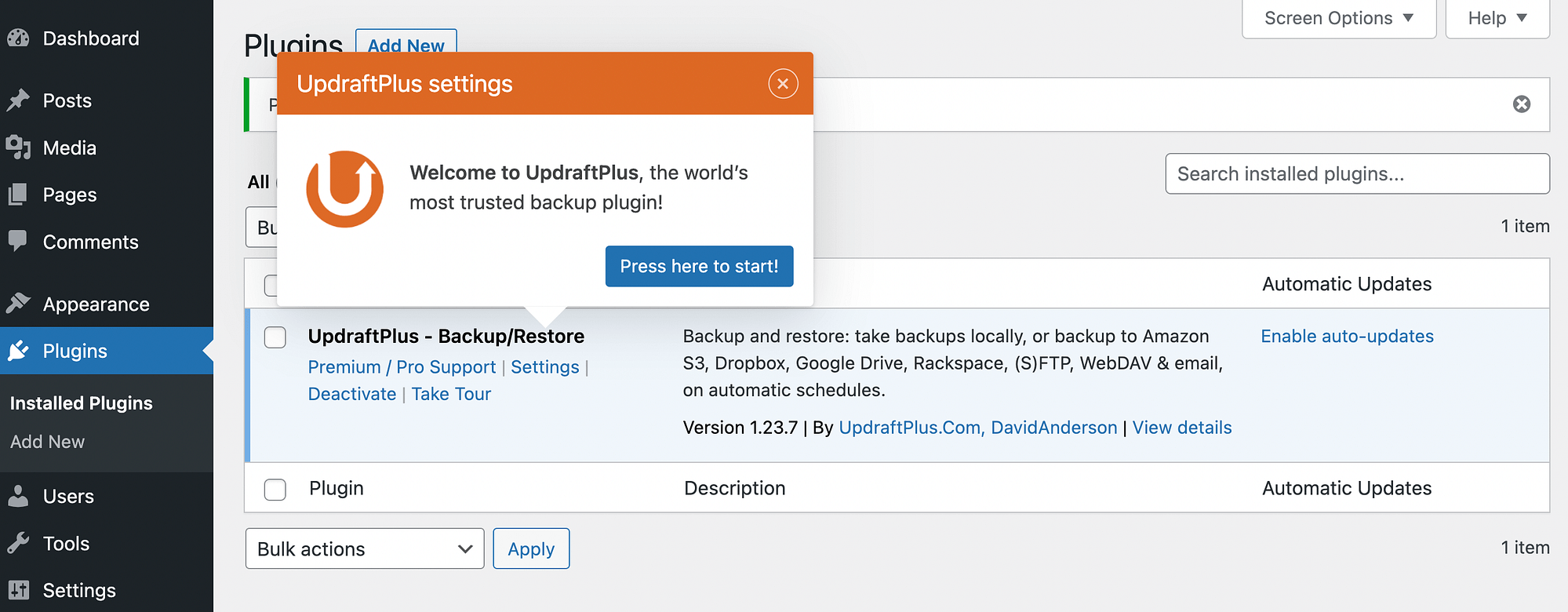
If you’d like a quick tour, go ahead and click on Press here to start!
Otherwise, simply go to Settings > UpdraftPlus Backups in your left-hand menu:
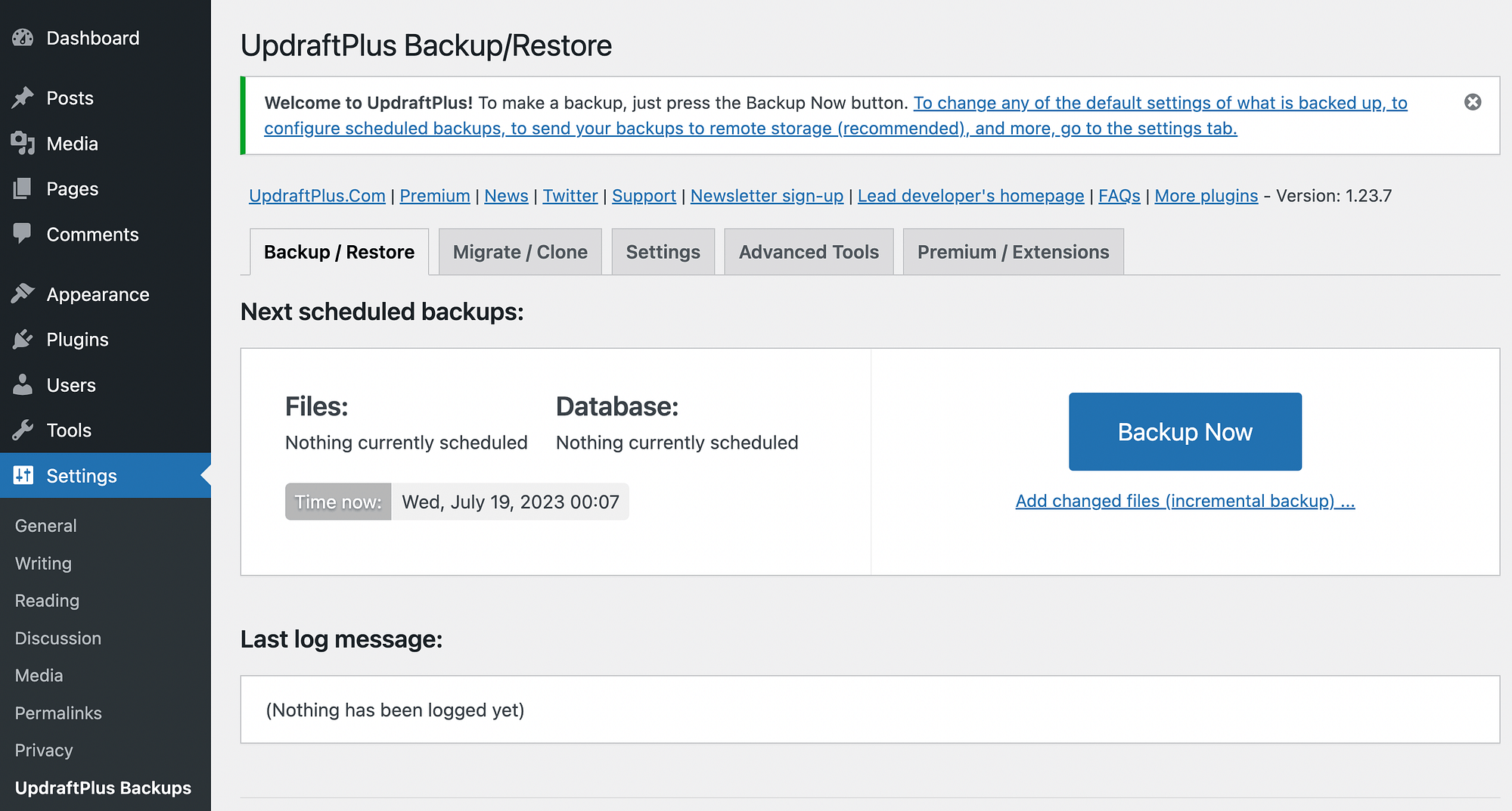
As you can see, you can easily hit the Backup Now button to create your first backup.
However, this will generate a manual backup with all UpdraftPlus’ default settings. We recommend taking the time to configure your backups to your preferences.
To do this, click on the Settings tab:
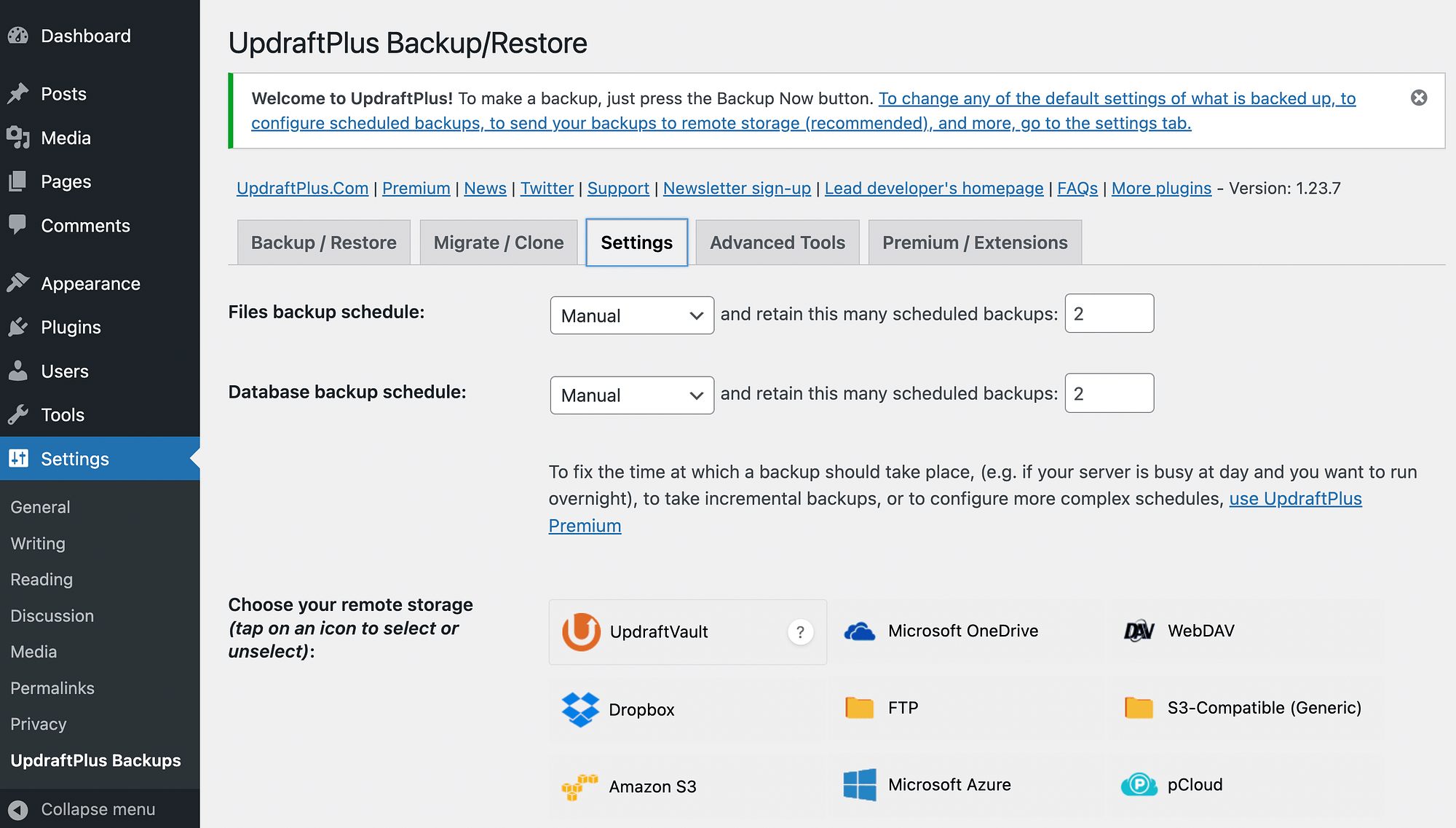
To setup your Files backup schedule, click on the dropdown menu next to it:
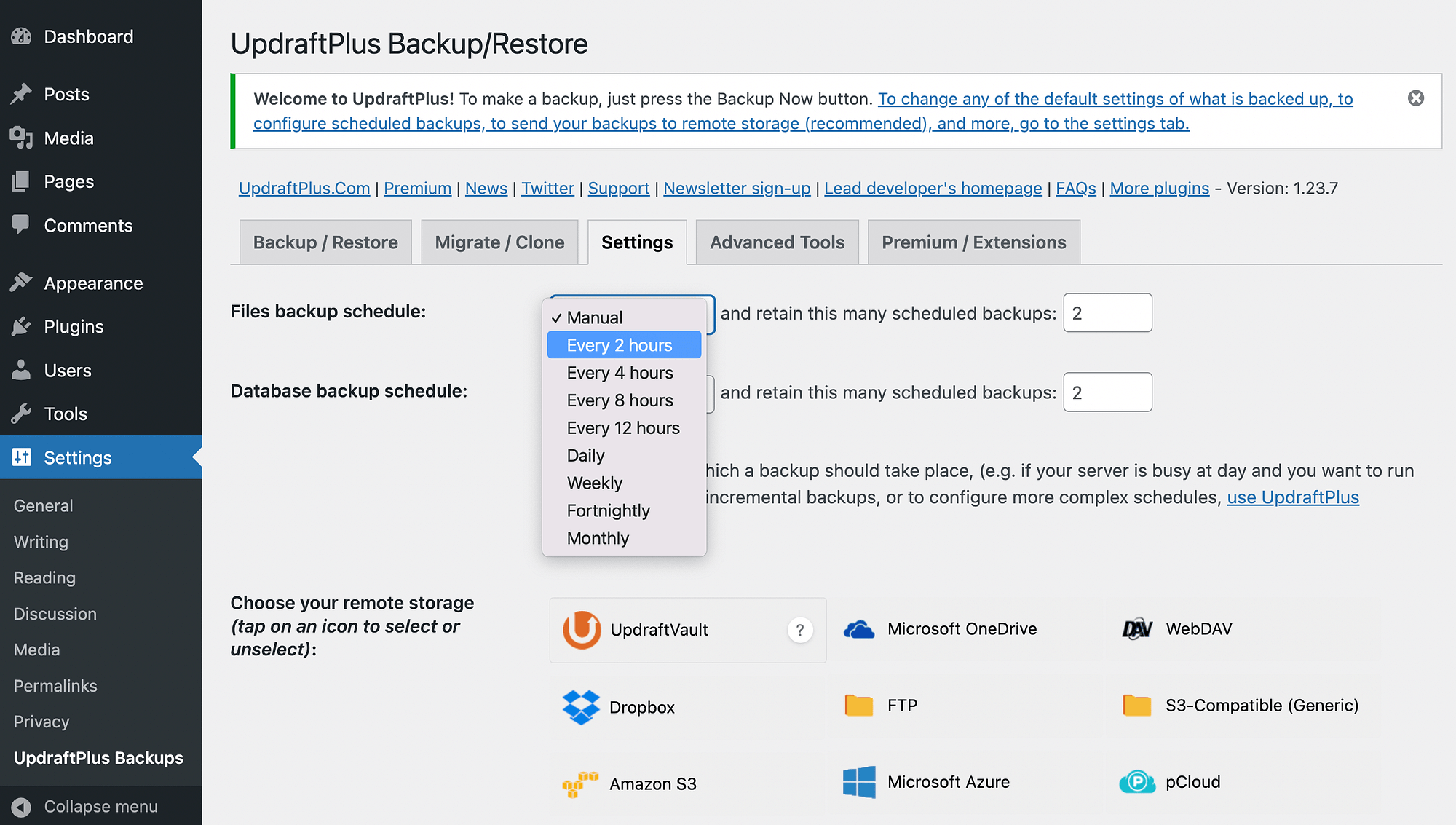
As you can see, you have the option to back up your WordPress site as infrequently as once a month or as frequently as every two hours. In most cases, you’ll want to opt for regular backups. The exact interval you’ll choose will depend on the volume of content you’re publishing and the traffic you’re getting. Most sites are good with one backup per day. If there’s more editorial activity on your site – multiple writers working on content – then you might want to back up your site more often.
On this page, you can also configure the amount of backups you want to hold on to. Generally, you should have access to at least two-week’s worth of updates. So if you’re backing up daily, that translates into holding 14 backups. If you’re backing up twice a day, then it’s 28, and so on.
Then, make your selections for Database backup schedule. To be safe, it’s a good idea to match this with your files backup schedule.
⚠️ Just to clarify how this works: your files backup consists of all the files stored on your server – this includes all the native WordPress files plus all your uploads, your theme and all the plugins you have installed on the site. The database backup is all your blog post and page data, user accounts, and site settings – basically everything that’s in the database of WordPress. Both the files backup and the database backup are equally as important.
After that, continue on to select your remote storage location. This is where your backups will be saved:
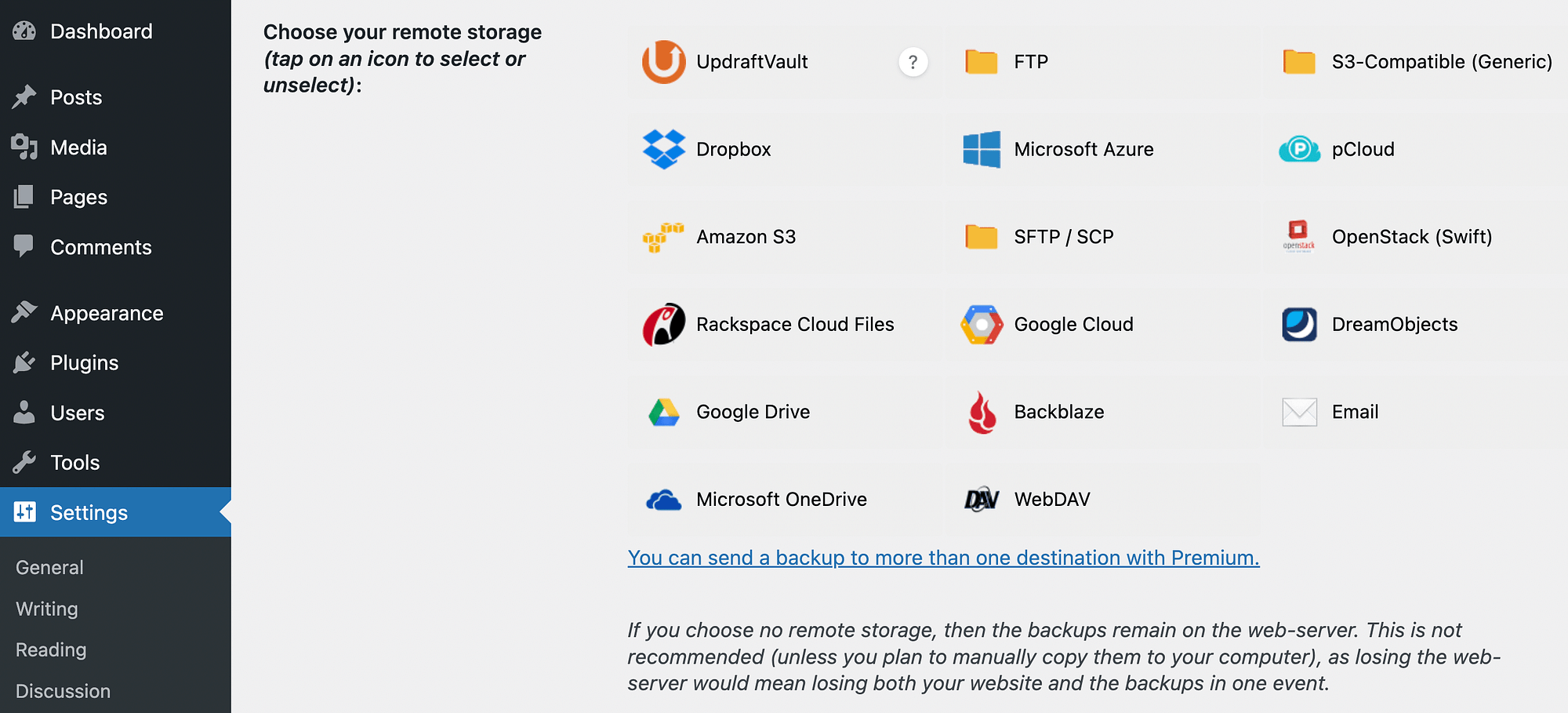
UpdraftPlus lets you use some of the most popular cloud storage options, including Google Drive and Dropbox.
Depending on your choice, you’ll need to complete some additional configurations.
For example, if you opt for Google Drive, you’ll then need to authenticate with Google:
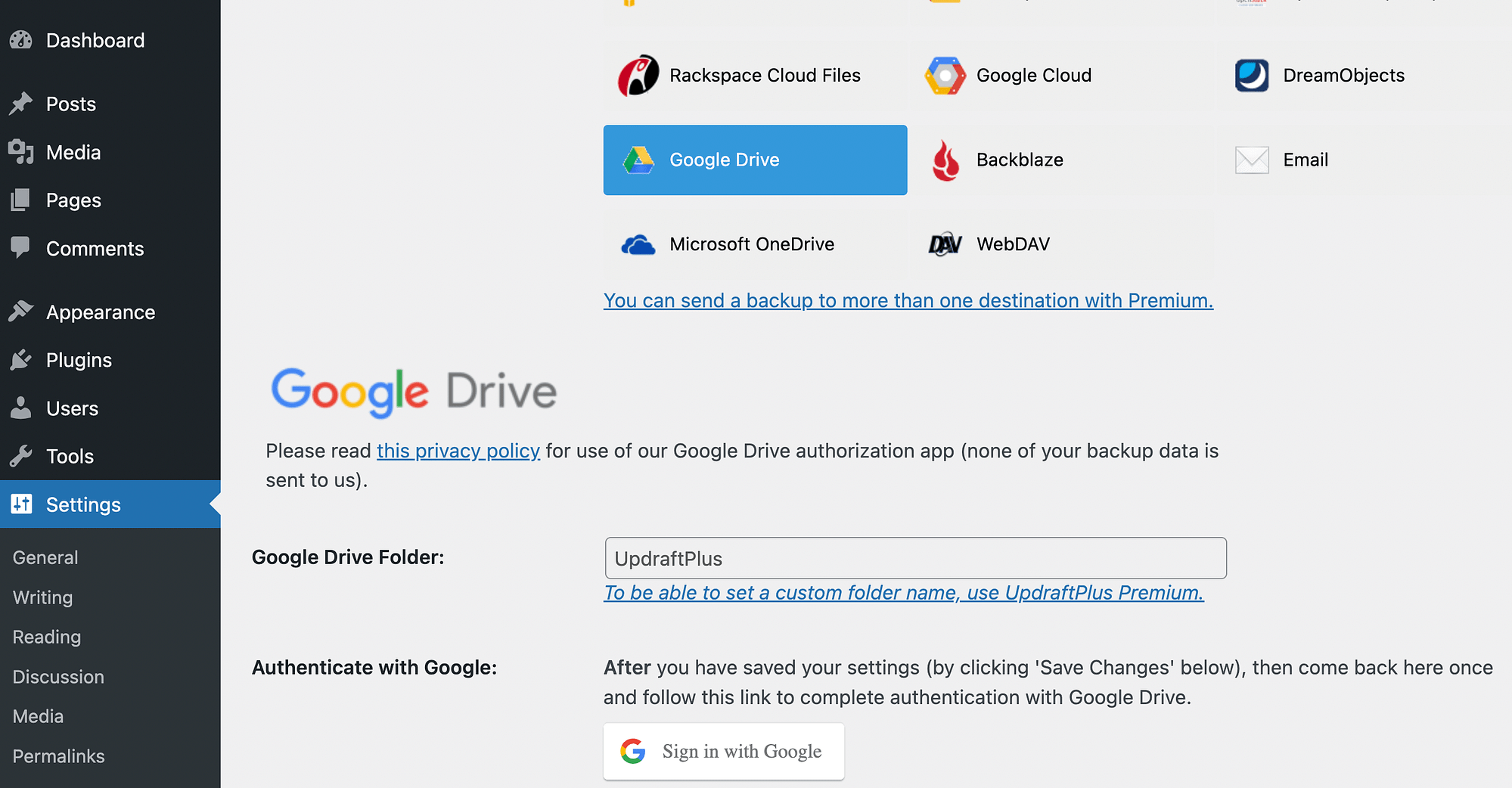
Next, proceed to the Include in files backup section:
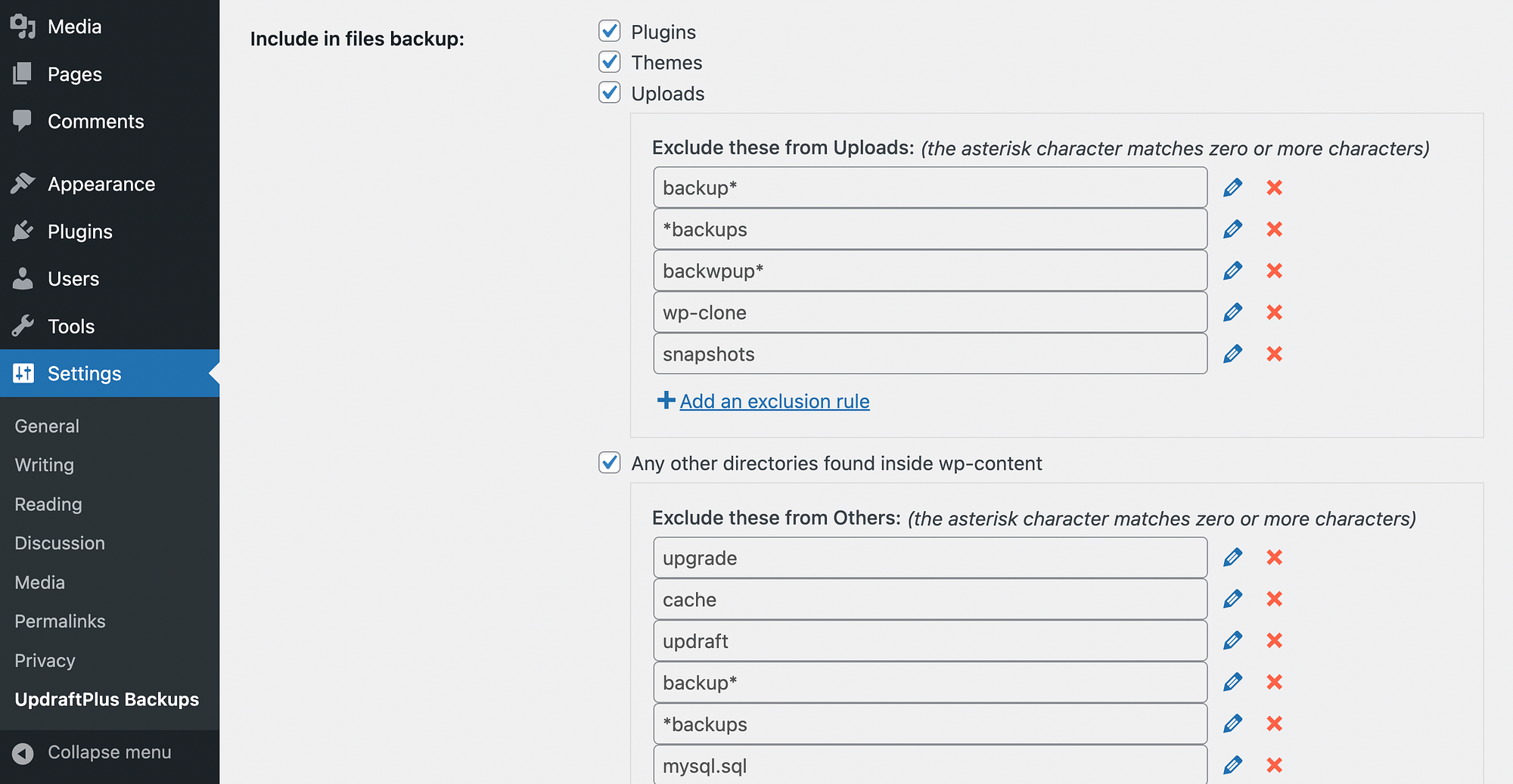
By default, UpdraftPlus includes your entire website, which is recommended. However, you can add an exclusion rule if you want.
When you’re happy with your selections, scroll down to the bottom of the screen and click on Save Changes.
Step 3: Restore your free backup 👨💻
Now that you’ve configured your backups, all that’s left is to learn how to restore them if it’s ever necessary – basically, there’s no point in learning how to backup a WordPress site for free if you then can’t use that backup if it’s ever needed. Luckily, this is super simple when you’re using UpdraftPlus.
Simply go to Settings > UpdraftPlus Backups > Backup / Restore. Then, scroll down to the bottom of the screen.
If you’ve already completed a backup, you should see it under the Existing backups section:
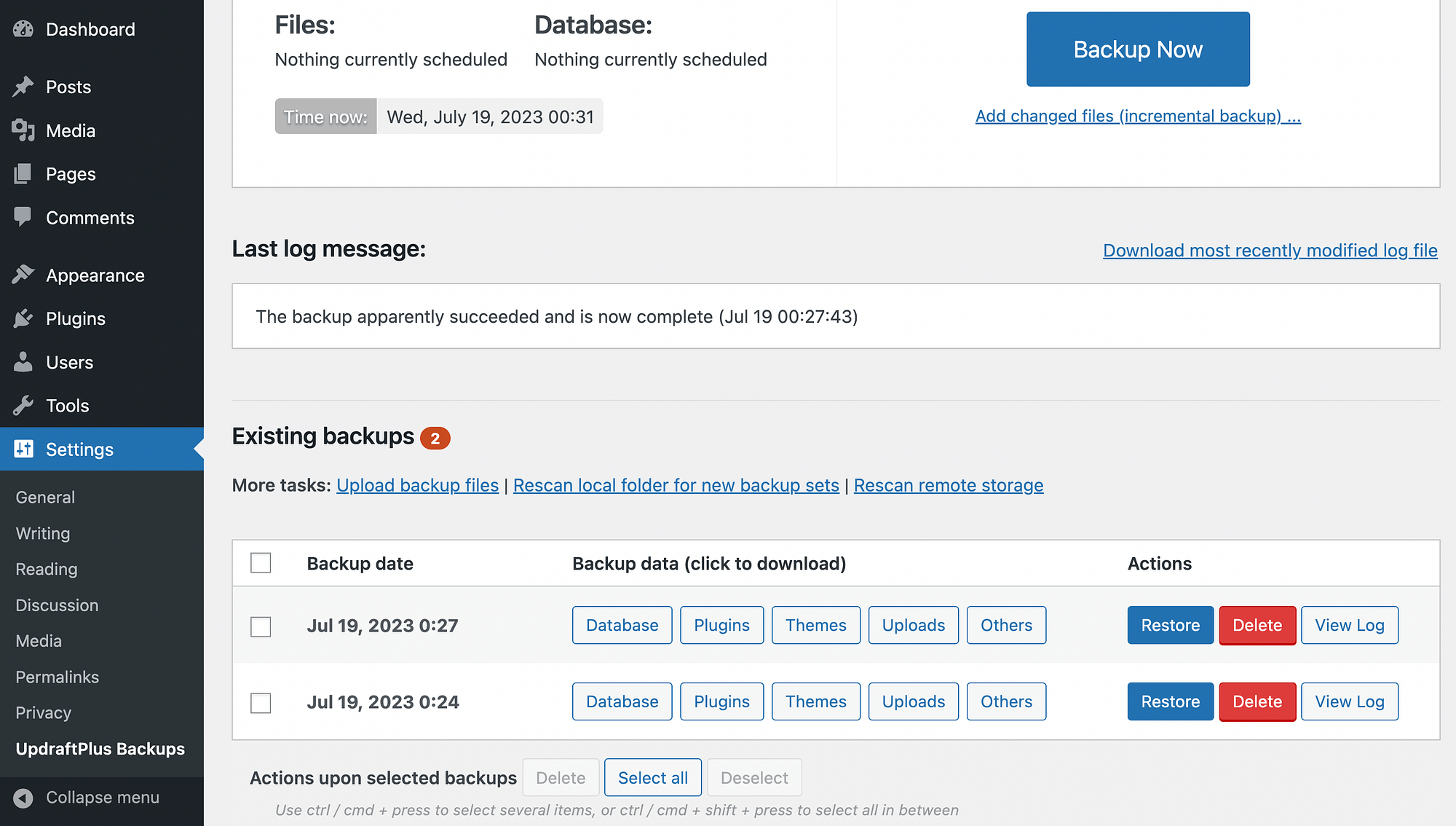
At this point, simply locate the backup that you’d like to use and hit Restore.
This will launch the restoration wizard. You’ll then need to choose which components of your site to restore:
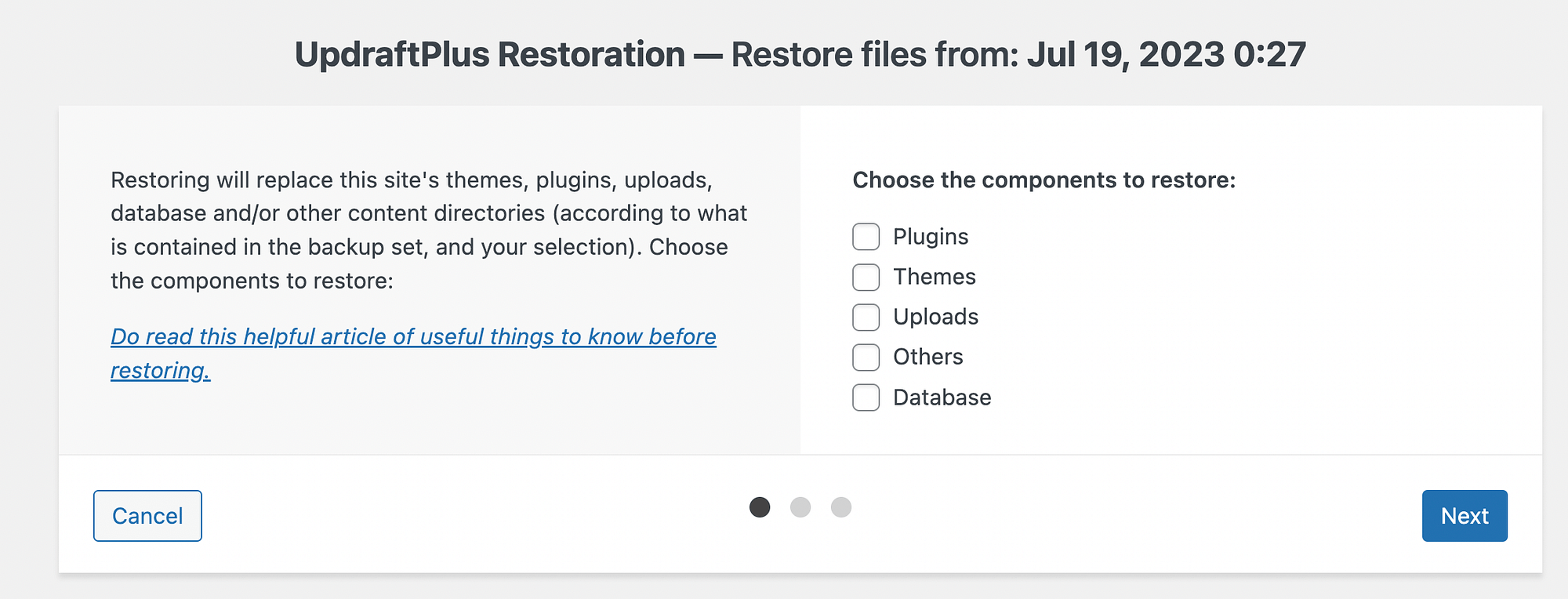
Just check the boxes to make your selections. After that, click on Next. You should see the following page:
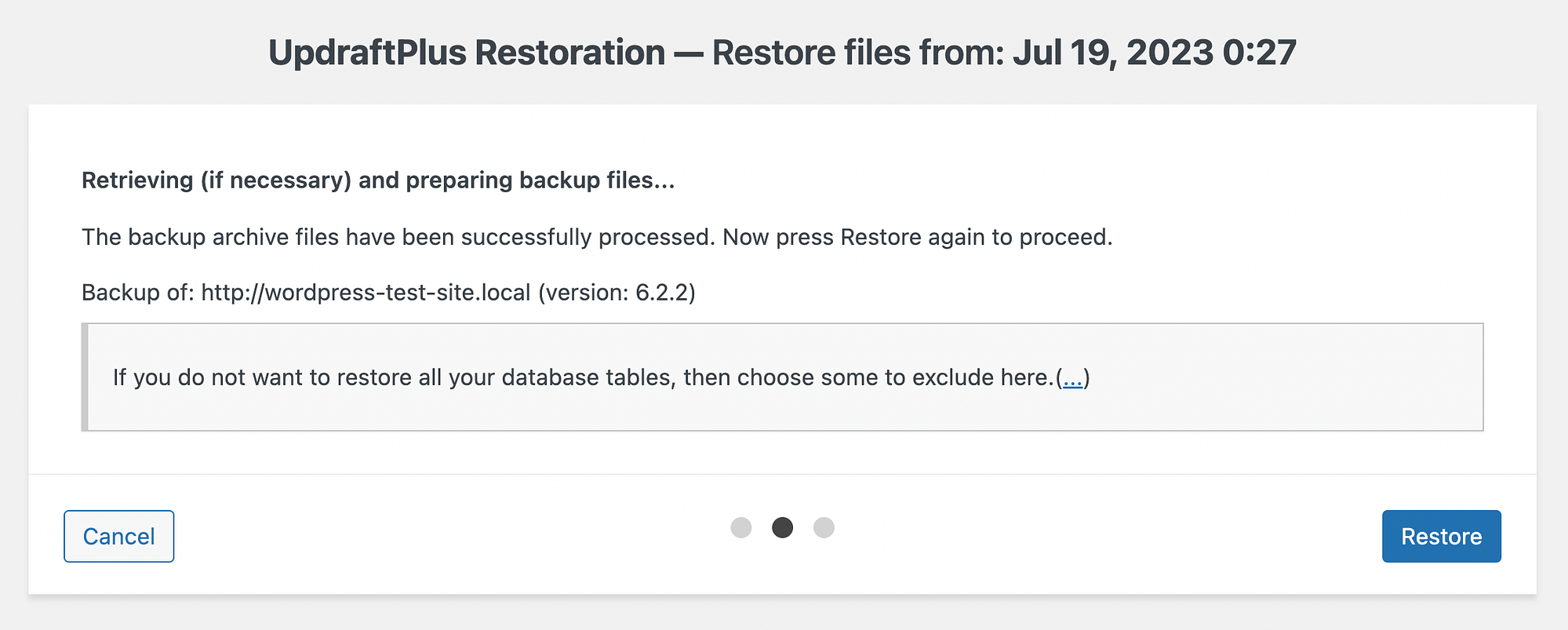
Now all that’s left is to click on Restore! If the restoration is successful, you will see something similar to the following:
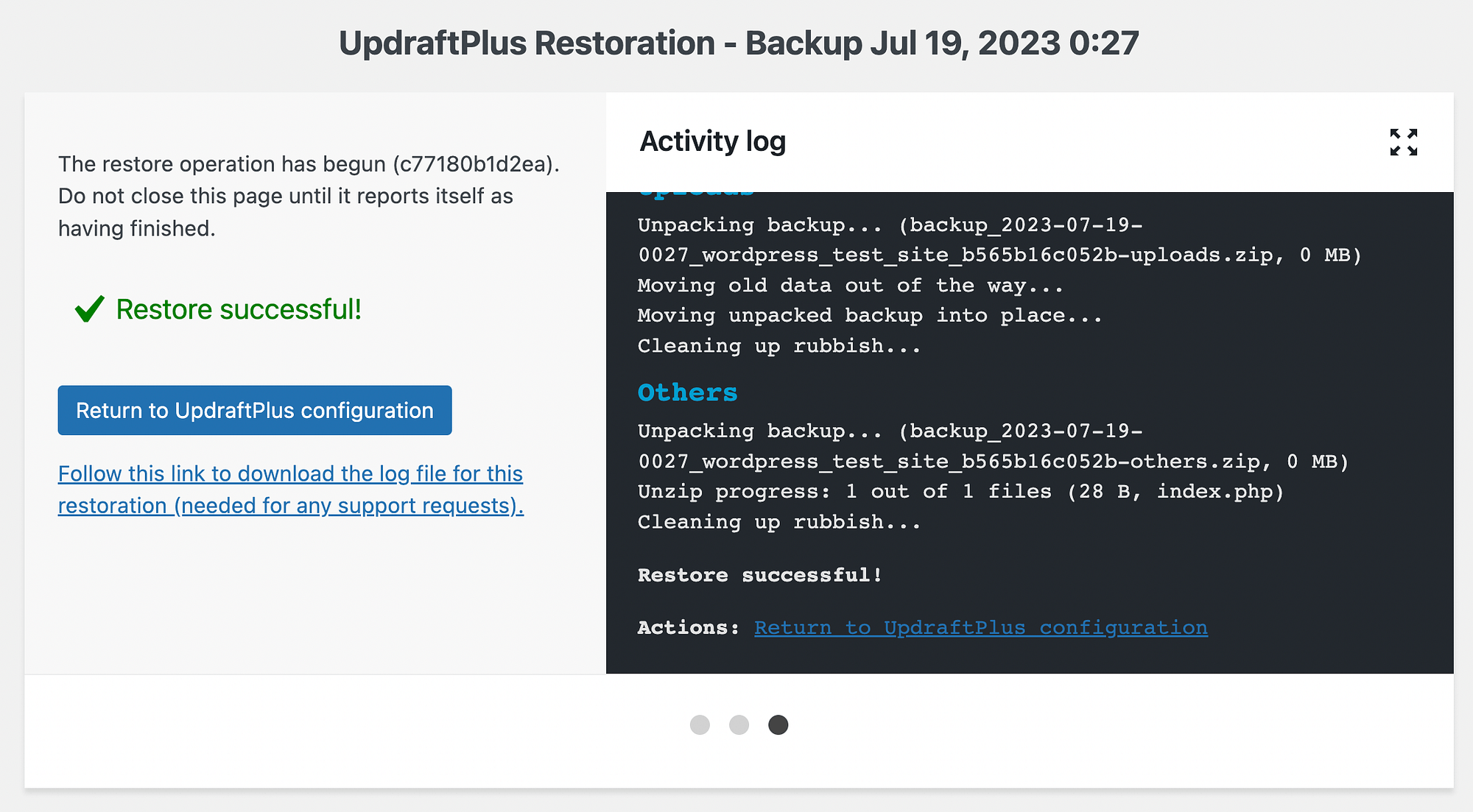
That’s it! Go ahead and hit Return to UpdraftPlus Configuration and your site should be good as new.
If you aren’t able to access the backend of your WordPress installation, and you’ve had to create a new one, simply install UpdraftPlus again and go to Settings > UpdraftPlus Backups > Existing backups:
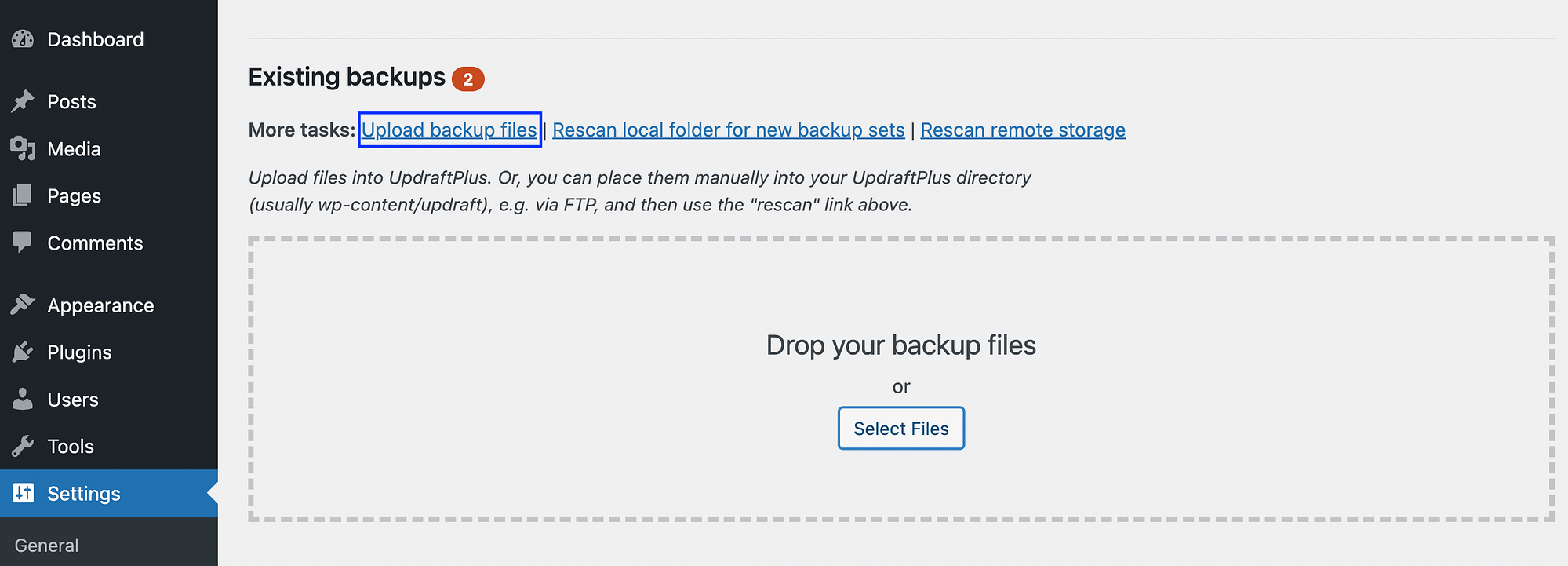
Then, click on Upload backup files. Simply select your backup files from the preferred remote location and complete the restoration process.
Conclusion 🧐
WordPress is a user-friendly and secure content management system by design. However, there’s always a chance that your site breaks or goes down. If that happens, you’ll want to be able to restore a secure copy of your website.
Therefore, you need to know how to backup a WordPress site (for free). The good news is that it’s super simple when you use a plugin like UpdraftPlus. All you have to do is install the tool, configure your backups, and then restore them as needed. It’s as simple as that!
Do you have any questions about how to backup your WordPress site (for free)? Let us know in the comments section below!


















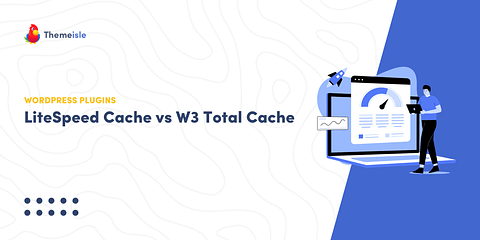

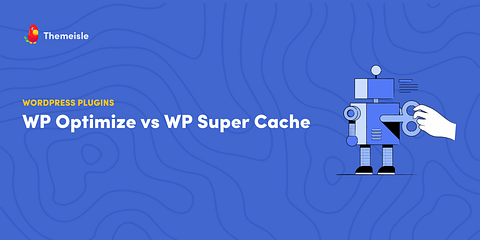

Is this backup plugin suitable for backing up woocommerce plugins too?
Hi Rebecca, yes you can back up and migrate WooCommerce sites with UpdraftPlus.
Loved it! Will install it ASAP! Just something I need!
Thanks Megan! You´re a great professional! Excellent Tutor!!!
Or start the conversation in our Facebook group for WordPress professionals. Find answers, share tips, and get help from other WordPress experts. Join now (it’s free)!